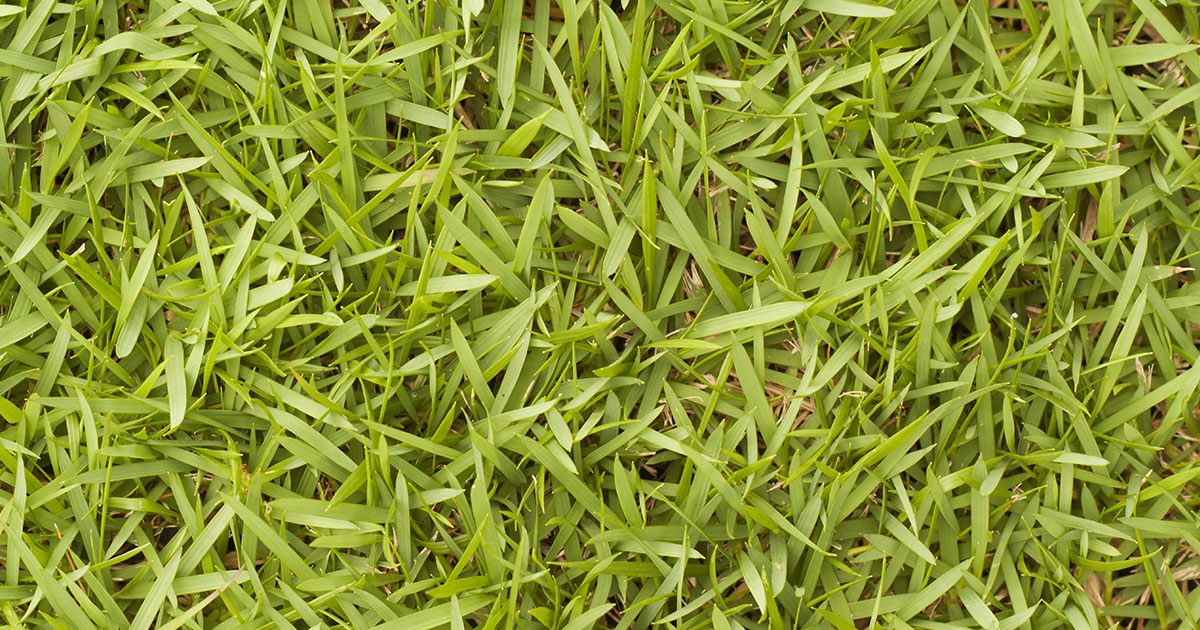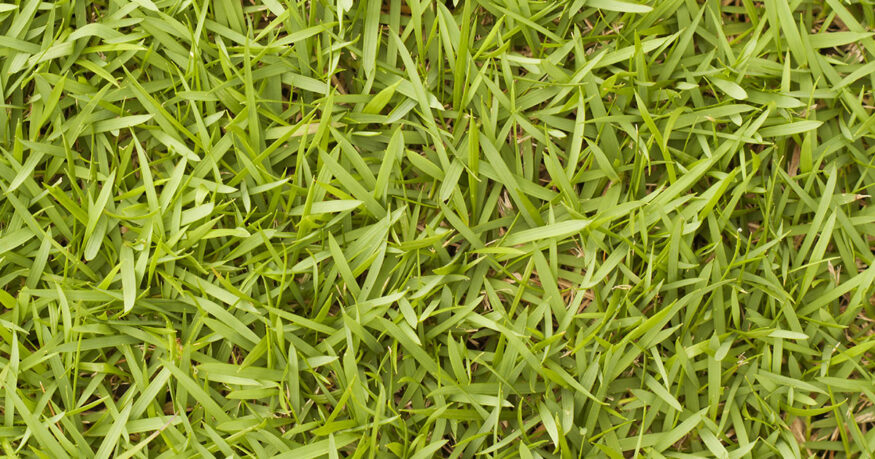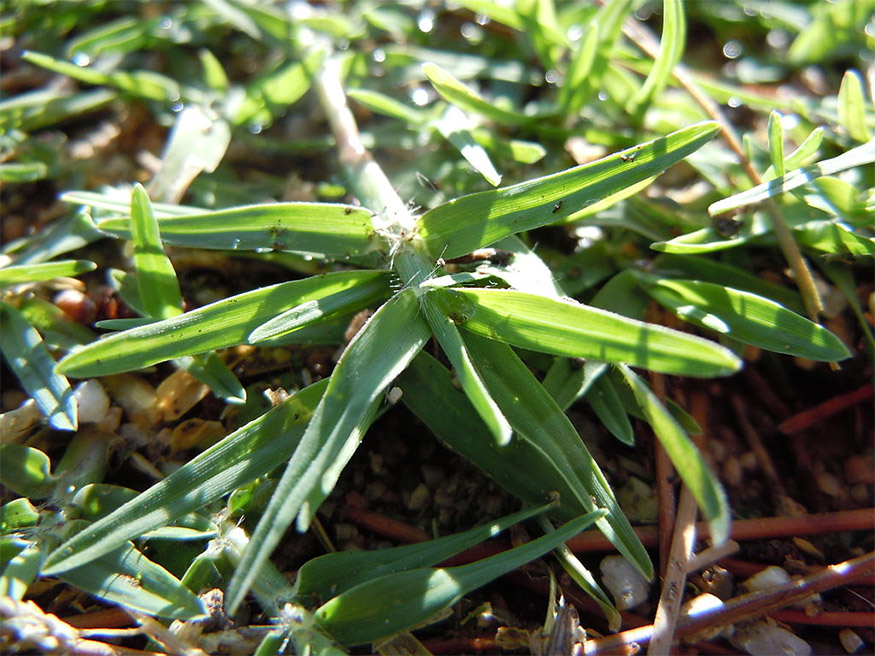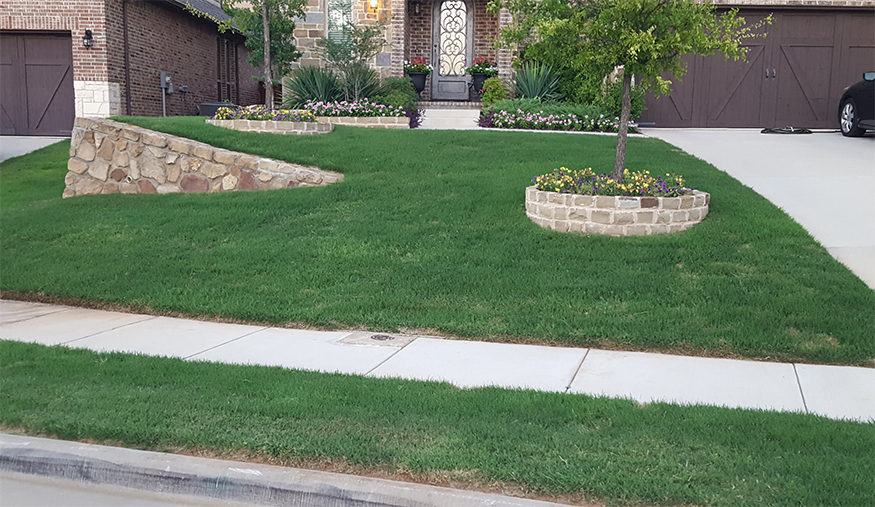Bermuda grass is extremely heat, drought, and traffic tolerant, making it an excellent choice for southern home lawns. But don’t think its hardiness means this grass is an easy keeper. Maintaining an attractive bermudagrass lawn requires a good deal of effort.
In this guide, we’ll look at important bermudagrass characteristics to determine if it’s right for your yard. We’ll also tell you everything you need to know to care for this warm-season grass using our helpful lawn care calendar.
Bermuda Grass Overview
| Also Known As | Bermuda grass, wiregrass; Cynodon dactylon L. |
| Type of Grass | Warm season perennial |
| Optimal Zones | Southern region |
| Root Structure | Deep |
| Winter hardiness | Poor |
| Heat tolerance | Excellent |
| Shade tolerance | Poor |
| Water Requirements | High |
| Drought Tolerance | High |
| Self Repair Capacity | Excellent |
| Overall Maintenance Requirements | Moderate to High |
The History of Bermuda Grass
The exact origin of bermudagrass in America is not well documented. The prevailing theory is that hay contaminated with seeds came from Africa along with slaves in the 1700s. Given that Cynodon dactylon is native to Africa and was naturalized in America long before its use as a turfgrass, this explanation tracks.
An account of American grass species published in 1807 lists bermuda grass as being widespread throughout the American South. Since the grass was also widespread across the island of Bermuda, it was believed this was the origin of it, hence the name. More likely, bermudagrass was also introduced to the island when slave ships stopped over on their way to America.
Bermuda grass was used exclusively as a forage grass until the early 1900s. Its ability to survive very low cutting heights and its high durability made it a great choice for golf courses and putting greens. In the 1950s, researchers started working on creating variants and hybrids that were better suited for home lawns.
Today, a number of bermudagrass cultivators and African bermuda grass crosses are available for southern region lawns.
Bermudagrass Growth Characteristics
Bermudagrass turf can survive severe drought, heat, and wear, but it doesn’t look great when forced to do so. To keep bermudagrass lush and beautiful, it must be carefully cared for.
To help you decide if Cynodon dactylon is right for your yard, let’s take a closer look at the characteristics of this species.
Type of Grass
Bermudagrass is a perennial warm-season grass. “Perennial” meaning it comes back every year. And “warm season” meaning it does most of its growing when temperatures are between hot.
Like zoysia and St. Augustine, Cynodon dactylon grows the most in the summer. In temperate climates, it goes dormant from the first frost until about May.
Optimal Zones for Bermuda Lawns
Bermudagrass is best suited for tropical and subtropical regions. In the US, it’s a popular turfgrass in southern areas. Certain cultivators bred for drought resilience are used throughout the South West and in Southern California.
Because of its sensitivity to cold, it is not a great choice for northern transition zones or northern regions.
Root Structure
Bermudagrass has an impressively deep root structure, reaching depths below 6 feet. But 80% of Cynodon dactylon roots don’t penetrate deeper than 6 inches.
The long roots help it survive droughts but the short roots are the ones that provide moisture most of the year.
Bermuda grass spreads via both stolons and rhizomes.
Winter Hardiness
Cynodon dactylon is not very cold hardy. It has difficulty surviving temperatures below 10 degrees. And anything under 30 is likely to cause severe leaf damage.
All varieties will turn brown and go dormant during cooler weather. They’ll begin to green up when temperatures are consistently above 50 degrees, usually by mid to late spring.
Heat Tolerance
Bermudagrass prefers very hot climates. Most growth occurs when daytime temperatures are between 95 and 100 degrees.
Shade Tolerance
Shady areas is one condition that Cynodon dactyloncannot handle well. This turf prefers good sunlight and even partial shade will result in spotty, unattractive growth.
Water Requirements & Drought Tolerance
Bermudagrass is one of the most drought tolerant warm season grasses. It survives by going semi-dormant sooner than most turfgrasses and remaining in that state for longer. But it is not attractive in this condition as it turns an unsightly shade of brown.
To keep bermudagrass looking its best, it needs a decent amount of water. In clay soil under the best conditions, it can thrive off of ¾ inch of moisture per week. In sandy soil under poor conditions, it will need over 2 inches per week.
Self Repair Capacity
Bermudagrass has a high self-repair capacity. It is often used for athletic fields and golf courses in the south due to this characteristic.
Bermuda Grass Varieties
There are numerous bermudagrass varieties available, each having subtle differences in color and growth.
We wont go into depth into each bermudagrass variety here, but the most popular types are:
- Celebration Bermuda grass
- Latitude 36 Bermudagrass
- NorthBridge Bermuda grass
- Tifway 419 Bermudagrass
- TifTuf Bermudagrass
- Tahoma 31 Bermuda grass
- Bimini Bermudagrass
Bermuda Grass Lawn Care Calendar
Keeping bermuda grass looking great requires plenty of water, fertilizer, and a consistent mowing schedule.
New lawns should be installed in late spring. Grass seed can be spread at a rate of 1 pound per square foot. Hybrid varieties are not fertile and must be installed as plugs or sod.
Brand-new lawns can be mowed after two weeks, or when seedlings growth hits about 2 inches in height. At this point, you can begin following our bermudagrass lawn maintenance plan, below.
Spring Care
Bermuda lawn will begin to green up and start growing in mid to late spring. But lawn maintenance will need to begin before this.
Mowing
The first mow of the season should take place right before the grass begins to green up in the spring. Set your mower lower than normal—to about 1 inch high. Use a mower bag to collect the dead cuttings to avoid adding to the thatch.
Once the grass begins growing, continue mowing at a height of about 1 1/2 inches every week. Leave fresh cuttings on the lawn to provide nutrients.
Bermuda lawn can be mowed with a rotary or push mower. But a sharp blade is necessary in both cases. If you notice tearing and browning at the grass tips, your mower blade is not sharp enough.
Fertilization
Fertilizing should only be done in the spring if there is zero risk of freezing weather and make sure you use a quality fertilizer. Bermuda grass that is encouraged to grow too quickly before frost will sustain damage.
Waiting until after May to fertilize is the best practice in most cases. This is, however, the best time to have a soil test done to evaluate missing nutrients.
Weed Control
Pre-emergent herbicide should be applied early in the spring, around mid-February. Applying again in late April will help further control weeds through the rest of the year.
Post-emergent weed killers should not be applied until after the grass is fully greened up. In the meantime, pull troublesome weeds by hand or use spot treatments.
Watering Bermuda Turf
Irrigation is generally not needed in spring assuming at least 1 inch of rainfall per week. When supplemental watering is needed, water deep, up to 1 inch at a time.
Pest and Disease Control
In warm springs, bermuda grass is susceptible to mole cricket damage. Unless the damage is severe, however, treatments should be delayed until summer when they will be more effective.
Check for excessive white grub activity by cutting a square of sod and peeling it back. More than 6 grubs in one square foot is a sign that treatment is needed. Use an insecticide spray in late spring.
Disease is typically not an issue in the spring.
Aeration and Dethatching
Spring is the best time to have your lawn aerated to avoid compact soil. Aerated soil is better able to accept nutrients and water. Spring aeration should be done right before the second application of pre-emergent weed control.
Bermuda grass is prone to thatch buildup. If your lawn has over ½ inch of thatch, use a dethatcher with 2 to 3-inch blade spacings. Narrower spacings will damage the lawn.
Summer Care
Summer is whenCynodon dactylon grows the most, especially in times of drought. It will need careful watering and mowing to thrive.
Mowing
Set your mower height between 1 and 2 inches for the summer. You can typically get away with shorter heights early on but should aim for closer to 2 inches during the heat of the season. This will help reduce stress and protect the root system.
Bermuda grass growing in shade will perform better if left at 2 inches all summer long.
As always, be sure to keep a sharp blade on your mower for the best results.
Fertilization
In early summer, apply nitrogen fertilizer at a rate of ½ to 1 pound per 1,000 square feet. Sandy soils will need the higher amount while clay soils will need the lower one. Based on the soil test you did in the spring, choose a product with high or low phosphorus and sulfur amounts.
In mid-summer, fertilize with nitrogen at the same rate, but assure the mix also contains high potassium. Again, choose the phosphorus amount based on your soil test.
In early August, apply another round of nitrogen and potassium fertilizer as you did in mid-summer. Potassium is important in helping Cynodon dactylon survive the winter.
Watering
Only water bermuda grass when it shows signs of moisture stress. It will take on a bluish-green color and won’t bounce back when walked on in the evening.
When this happens apply ¾ to 1 inch of water in a single watering. Early morning is the best time to do this. Sandy soils in high heat may require two watering sessions to apply up to 2 inches in moisture to the lawn.
In periods of no rainfall, you will likely have to water once a week. But it’s best to let the grass tell you when conditions are too dry.
Weed Control
Apply broadleaf herbicide in the early summer after the grass is fully greened up but before daytime temperatures get over 90 degrees. This is only necessary if weeds are a problem. Choose a product safe for bermudagrass.
Alternatively, you can pull weeds manually or use spot treatments as needed.
Pest and Disease Control
Pests can be a big problem for bermudagrass in the summer. The most common suspects are:
- Mole crickets
- Bermudagrass mites
- Grubs
- Nematodes
- Bermudagrass scale
- Ground pearls
Each requires its own specific treatment, but most can be targeted this time of year. Keep an eye out for damage and treat only when necessary.
Large Patch and Dollar Spot can occur in summer. This is typically a sign of too much moisture in the turf. Watering infrequently and just before sunrise will help.
Thatch buildup can also contribute to damage from these funguses. Only dethatch right now if your grass is not stressed and temperatures are not too high, otherwise wait until late summer.
Repair
Bare spots in lawns should be addressed in early summer by planting grass seed or plugs as needed. Some varieties can also be put in at the end of summer.
Fall/Autumn Care
The fall season is all about preparing your bermudagrass for winter dormancy.
Mowing
Continue mowing at about 1 ½ inches until nighttime temperatures cool to below 70 degrees. At this point, raise the mower ½ inch to allow for more leaf surface.
As usual, make sure your blade is very sharp to avoid leaf damage.
Fertilization
Do not apply nitrogen fertilizer this time of year.
The most important nutrient for fall is potassium, as this will help Cynodon dactylon survive dormancy. If your soil test shows low potassium, add 1 pound of potash per 1,000 square feet about 6 weeks before the first expected frost.
While winterizer fertilizer can be helpful for cool-season lawns, it is not recommended for bermudagrass in most cases.
Weed Control
Control winter annual weeds and invasive grasses by using a pre-emergent weed control spray in September and again in late November.
Watering
Irrigation is generally not needed in the fall. However, if there is not much rainfall, you may need to supplement as you did through the summer.
Once grass goes dormant continue to keep an eye on moisture levels. If no precipitation occurs for 3 weeks, apply about ¾ inch of water when temperatures are above freezing.
Disease Control
Keep an eye out for fungus problems this time of year. Large Patch, especially, can spread rapidly in moist, cool conditions. Treat with fungicides as needed.
Overseeding
Fall is the best time to overseed your lawn with cool-season grasses for winter color. Bermudagrass is a great candidate for overseeding with perennial ryegrass. Begin spreading this seed about 45 days before the first frost.
You can find out more about how to overseed warm-season grasses, here.
Winter Care
Bermudagrass will start to go dormant as soon as temperatures drop below 50 degrees overnight. After the first freeze, it will be completely dormant. From here, care revolves around assuring the grass doesn’t get too dry.
Watering
Continue monitoring moisture accumulation through the winter. If more than 3 weeks pass without precipitation, apply ¾ inch of water as soon as daytime temperatures get above freezing.



